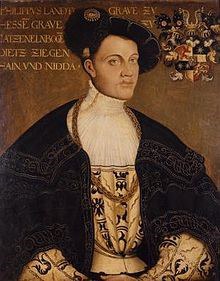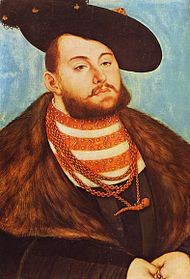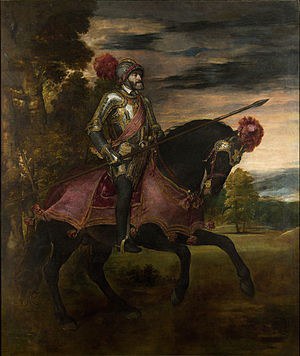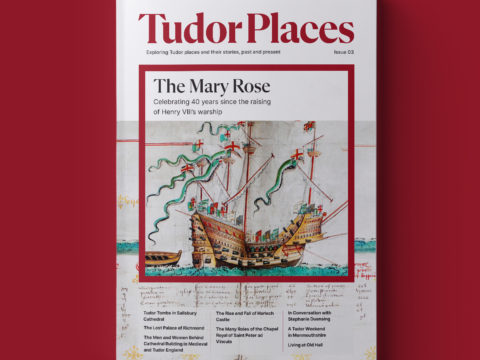Schmalkaldic League
Background
The Schmalkaldic League, formed in February 1531, in the small town of Schmalkalden in the German duchy of Hesse was born of religious and political turmoil. It was a league of rulers within the Holy Roman Empire, politically subject to the emperor, Charles V, who had become disillusioned with the Catholic church, and had turned to the new doctrines, espoused by Martin Luther, and Philip Melancthon.

Following the Diet (the diet was the assembly of Imperial princes) of Worms in 1521 when the emperor tried to persuade Luther to recant his ‘heresy’, the former Augustinian monk found refuge with Frederick III, Duke of Saxony. Over the course of the decade, his teachings spread and in 1529, the Landgrave Philip of Hesse persuaded some of the free cities of the empire and other evangelical rulers to bind together in a ‘Protestation’ against the traditional church. (Evangelical was the term used before this date for those who wanted reform of the church – they ranged from thinkers such as Erasmus, who remained Catholic, to those who were rapidly beginning to think Luther had not gone far enough).
As the evangelicals grappled with theology, many new interpretations of the bible and the church fathers proliferated – dismaying the ruling class. Philip of Hesse tried valiantly to bring Luther and Melancthon on one side and the Swiss Reformer, Zwingli and his colleague Oecolampadius on the other, into agreement at a diet at Marburg, but failed – their core disagreement was on the nature of the Eucharist.
Despite this, all the Protestants, as they were now called, were able to agree on fourteen articles of faith. This was developed by Melanchthon for presentation to the emperor on 25th August 1530, at the Diet of Augsburg. It was hoped that Charles, reeling from the collapse of his brother’s kingdom of Hungary in the face of the encroaching Ottoman empire, might be in a mood for compromise – especially as amongst his advisors were Humanists who had sympathy with concerns about corruption in the Church. But Charles could not bring himself to step outside strict orthodoxy.
Instead of being a route to reconciliation, Melanchthon’s articles, now known as the Confession of Augsburg, came to be a founding document of the Lutheran faith. Generally, the followers of Lutheran and Melanchthon have become known as Protestants whilst followers of the more radical interpreters of faith, such as Zwingli, Bucer and Calvin, are referred to as Reformed Protestants.
Creation of the League
Charles, having rejected the Confession of Augsburg, pursued an aggressive policy to bring what he considered rogue state back into line. The League was formed in February 1531, as a mutual defence pact between those German rulers who had accepted the Confession of Augsburg as the definition of their faith. The states agreed to a pact of joint defence against Charles, promising each other to provide some 20,000 infantry and 2,000 cavalry. Members included Johann Friederich, Elector of Saxony, whose wife was Sibylle of Cleves, Philip of Hesse, Anhalt, Pomerania and the Imperial free cities of Frankfurt and Strasbourg. In 1538 and 1539, Denmark and Brandenburg joined, respectively, and a year later, the Palatinate. The duchy of Jülich-Berg-Cleves did not join: although its duke had rejected papal authority, he remained doctrinally Catholic.
Overtures to England and France
In 1531, the Englishman Robert Barnes, once an Augustinian friar, but an early convert to Lutheran ideas, for which he had been punished before escaping to Wittenberg, was invited by the German Lutheran princes to visit them. Soon after, he returned to England, where he was protected by the king’s chief minister, the reform-minded Thomas Cromwell and by 1535, Henry VIII, in his most reforming mood, was willing to send Barnes, Edward Fox and Nicholas Heath to Wittenberg for serious negotiations with the League. The price of an alliance was for Henry to subscribe to the Confession of Augsburg, and Philip Melanchthon’s Apology.
Henry did not dismiss the idea out of hand, although his conservative secretary, Bishop Gardiner of Winchester, was discouraging. Henry invited Melanchthon to head an embassy to England, and in anticipation, the Wittenberg Articles were created by the Reformer – they were not identical to the Confession, but were clearly Lutheran, rather than Catholic. The embassy did not materialise, and the articles were not implemented in England, although they did inform the evangelical tone of the Ten Articles of faith issued in 1536 for observance in England.
Henry lost interest in the alliance – perhaps owing to the replacement of the evangelical Anne Boleyn with the conservative Jane Seymour – or perhaps chastened by the Pilgrimage of Grace. Talks petered out. They were resurrected in early 1538, when Henry, faced with a threat from the alliance between Charles V and François I of France, again sought an alliance with the League and sent Christopher Mont, a native of Saxony but now in Henry’s service, to negotiate.
The upshot was another collection of articles, this time known as the Thirteen Articles, similar to the Wittenberg Articles. Their promulgation was followed by a delegation of three German Lutheran theologians – Franz Burchard, Georg von Boineburg and Friedrich Myconius - to England. The delegation pleaded long and hard with the English convocation of clergy to accept these new articles, but despite Cromwell, as Henry’s Vicegerent (deputy as Supreme Head of the Church), being in favour of their views, the majority of English clergy remained traditional in their religion and blocked further innovation. The German delegation gave up and returned home by October 1538.
In France, the evangelical movement had strong support from the king’s sister, Marguerite of Angoulême, Queen-consort of Navarre, whose daughter, Jeanne III of Navarre, was later the leader of the French Protestants, or Huguenots. François, however, was less interested in evangelicalism than his sister, and, when dissident radicals publicly attacked the Mass in 1534, in the Affair of the Placards, he turned against the reformers, ordering over twenty executions.
Diplomacy
Meanwhile, in 1537, Luther planned to present his Schmalkaldic Articles to the League as a basis for negotiation with Charles, specifically in regard to calling a council of the German church, something that had been demanded and resisted for twenty years. Luther was ill, and did not attend himself, so Melanchthon advised against the use of his articles, on the basis that Luther’s very name was a red rag to a bull so far as Charles was concerned.
In England, Henry VIII had lost whatever enthusiasm for reform he had once had, and the Act of Six Articles, which came into force in June 1539 confirmed traditional Catholic practice. Nevertheless, Henry was still willing to consider a political agreement with the League, to give encouragement in their resistance to Charles, in the hopes that that would distract the emperor from any notion of invading England. In January 1538 Christopher Mont was again sent to Saxony to liaise with Johann Friedrich – the bait Henry offered was his own marriage to a suitable ally of the League, and perhaps also a marriage for his elder daughter, Mary. What transpired was Henry’s marriage to Anne of Cleves, sister-in-law of Johan Friedrich.
In France, after his anger of 1534, François was willing, once again, to talk to the Protestants. In 1536, he issued pardons to the ‘Sacramentarians’ – that is, those who opposed the Mass - and issued an invitation to Melanchthon to visit Paris – an offer that was not accepted. In 1542, François formally allied with the League, to aggravate Charles. Since the French king was also willing to ally with the Sultan of Turkey, we may infer that his motives were political, rather than religious.
Destruction
In 1545, the Pope Paul III finally called a General Council of the Church, at Trent. It was too little and too late to save the unity of Christendom. Even some Catholic countries did not send representatives, and many who continued to see themselves as Catholics were unhappy with the findings, particularly on the doctrine of Justification. The Council affirmed that humans participated in their own salvation through ‘good works’ including hearing Mass and praying for the dead. This was in direct opposition to Luther’s belief that Justification (ie salvation) was given by the Grace of God alone, through faith.
In 1546, Charles stepped up persecution in his own personal territories in the Low Countries. Antwerp had been a hot-bed of the new ideas, reflecting its importance as a centre of the printing industry. A further attempt by the League at discussion with the emperor at the Diet of Regensburg was batted off by Charles, who would no longer accept the League members’ assurances that they were still loyal to his authority and that of the true, by which they meant suitably reformed, Church.

He became even more infuriated when the Archbishop of Cologne, von Wied, who was one of the electors (the body of princes, dukes and bishops who elected the emperor) joined the League, although von Weid continued to hope for reconciliation between the sides. Now that Charles was, at least for the time being, at peace with François, he could turn his attention to the League. He determined to strike at its head, Johann Friedrich, Elector of Saxony.
He was helped by Johann Friedrich’s cousin, Maurice, Duke of Saxony (the insanely complicated history of the duchy is outside the scope of most people’s attention span, including ours!). Maurice, although a Lutheran himself, was keen to get his hands on his cousin’s portion of Saxony and was willing to lead Charles’ troops.
The Imperial forces won an overwhelming victory at Mahlberg on 23rd April 1547, an event which Charles commemorated by commissioning a portrait of himself in armour, by Titian. Johann Friedrich and Philip of Hesse were taken prisoner and The Palatinate and Wurttemburg surrendered. Nevertheless, Charles was not having it all his own way. Magdeburg and Bremen continued to resist, and the latter was under siege for five months. Following the suppression of the League a substantial swathe of Lutherans sought refuge in England, now under the rule of the Reformist Duke of Somerset, as regent for his nephew, Edward VI.

In May 1548, the emperor offered what he saw as a compromise – the Augsburg Interim. This would allow Lutherans to return to the church unpunished for their alleged heresy, and matters would stand over until another session of the General Council of the church was convened – in the interim, the marriage of clergy, and the giving of communion in both kind would be allowed.
These concessions did not go far enough. Four years later enough of the German princes were holding out for Lutheranism to force Charles into the Peace of Passau. The two captives, Johann Friedrich and Philip, were released. Johann Friedrich returned to his family, in something like triumph, confirming his support of the Confession of Augsburg, from which he swore he would never deviate. He died in March 1554.
Eighteen months later, in September 1555 (less than a year before Charles gave up the unremitting struggle to rule his vast empire, and abdicated) the Peace of Augsburg confirmed that Lutheranism was to be accepted within the empire, wherever the local ruler allowed it – an agreement summarised in the Latin ‘cuius regio, eius religio’. If you did not like the choice of religion your ruler had selected, you could move to another principality.
This was better than nothing, but did not address the issue that many states contained large numbers of both groupings – one set or the other would have to acquiesce with government policy or go into exile from their home territory. Additionally, no variants of Christianity were to be permitted other than Catholicism or Lutheranism (as defined in the Confession of Augsburg), disappointing the Reformed Protestants, who now built up followings in Geneva and Frankfurt, and found a ready audience in the England of Edward VI.
Philip of Hesse, whilst maintaining his own Lutheranism, worked hard until his death in 1567, to bring all the Protestant groups together, and never entirely despaired of a reunification of Christendom.
MacCulloch, Diarmaid. Reformation: Europe’s House Divided ; 1490 - 1700. Penguin History. London New York, NY Toronto: Penguin Books, 2004
MacCulloch, Diarmaid. Thomas
Cromwell: A Life. London: Allen Lane, an imprint of Penguin Books, 2018
Scarisbrick, J. J. Henry VIII. Yale English Monarchs. New Haven: Yale University Press, 2012
